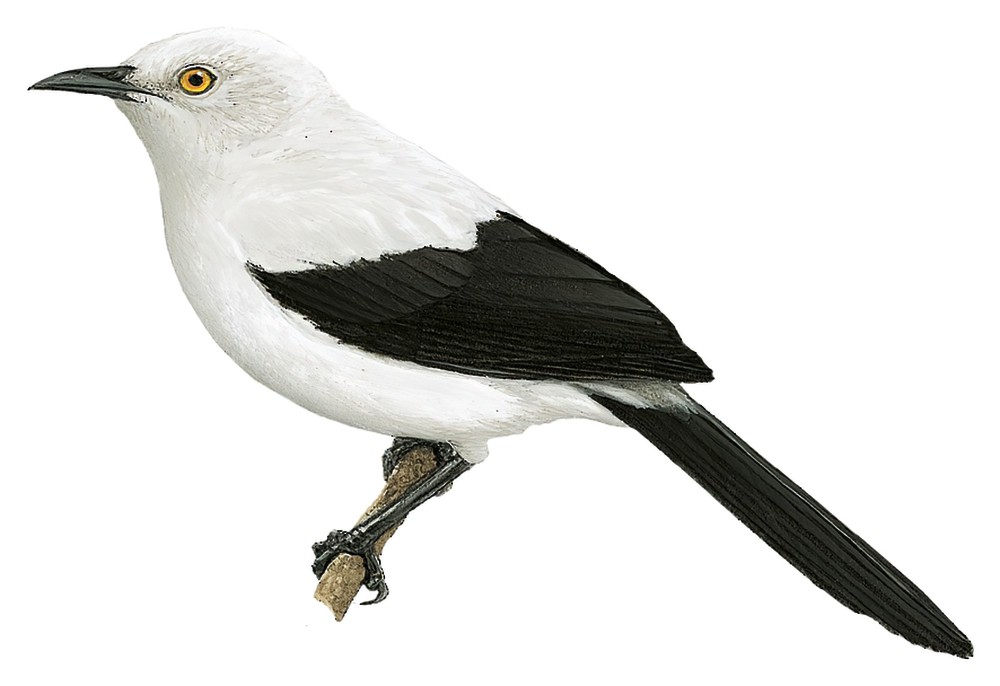Southern Pied-Babbler / Turdoides bicolor

Southern Pied-Babbler
SCI Name:
Protonym: Cratopus bicolor Edinb.J.Nat.Geogr.Sci. n.s. 1 no.2 p.97 pl.3
Taxonomy: Passeriformes / Leiothrichidae / Turdoides
Taxonomy Code: sopbab1
Type Locality: South Africa.
Author: Jardine
Publish Year: 1831
IUCN Status: Least Concern
DEFINITIONS
TURDOIDES
(Leiothrichidae; Ϯ White-headed Babbler T. leucocephala) Genus Turdus Linnaeus, 1758, thrush; Gr. -οιδης -oidēs resembling; "Turdoides leucocephala, (Mus. Francof.) Weißköpfiger Droßling. ... Die Droßlinge (Turdoides) bilden eine von den Droßeln (Turdus) wohl zu unterscheidende Familie, die eine Menge von Arten zählt, von denen Rüppel bereits vier aus dem nördlichen Afrika eingesendet hat. Wir werden die Abbildungen und Beschreibungen von dreyen derselben in dem Atlas liefern. Auch erwarten wir duie Bekanntmachung anderer in Indien entdeckten Arten der Gattung Turdoides von Herrn Temminck, der solche zuerst aufgestellt hat." (Cretzschmar 1827); "Turdoides Cretzschmar, 1827, in Rüppell's Atlas, Vög., hft. 4, p. 6, pl. 4. Type, by monotypy, Turdoides leucocephalus Cretzschmar." (Deignan in Peters 1964, X, 331).
Var. Tordoides.
Synon. Aethocichla, Aipunemia, Crateropus, Cratopus, Ischyropodus, Layardia, Malacocircus, Malcolmia, Pengia.
turdoides
L. turdus thrush; Gr. -οιδης -oidēs resembling.
● “Both Seebohm and Saunders have used Meyer’s name Sylvia turdoides, 1815, for the Great Reed-Warbler, because, according to the first named, Linnaeus in placing the species under the genus Turdus made the definition quite misleading. Turdus arundinaceus of Linnaeus was, however, founded on Klein’s Turdus musicus palustris, which undoubtedly refers to the Great Reed-Warbler, and there can be no objection to the name, which is the oldest and has always been more or less in use” (BOU 1915) (syn. Acrocephalus arundinaceus).
● “Altogether of a much Thrush-like appearance” (Hartert 1896) (Cataponera).
● "14. COLLURICINCLE GRIVELÉ. — COLLURICINCLA TURDOIDES. ... Ce Colluricincle est originaire de Raffles-Bay. Il appartient à la section des espèces de ce genre qui est caractérisée par un bec plus large et moins comprimée. Ses couleurs et sa petite taille le rapprochent du Colluricincla brunnea Gould; il s'en isole par la coloration à peu près uniforme de la région thoraco-abdominale." (Pucheran 1853) (syn. Colluricincla parvula).
bicolor
L. bicolor, bicoloris bicoloured < bi- two- < bis twice; color, coloris colour; epithet usually given to spp. with white underparts and contrastingly darker upperparts.
● ex “Crested Titmouse” of Catesby 1731, and “Mésange hupée de la Caroline” of Brisson 1760 (Baeolophus).
● ex “Coucal Noirou” of Levaillant 1807, pl. 220 (syn. Centropus nigrorufus).
● ex “Colibri Nr. 2” of Fermin 1769, “Saphir-émeraude” of de Buffon 1770-1783, and “Sapphire-and-Emerald Humming-bird” of Latham 1782 (Cyanophaia).
● ex “Pic varié de la Encénade” of d’Aubenton 1765-1781, pl. 748, fig.1, and “Encenada Woodpecker” of Latham 1782 (syn. Dendrocopos lignarius).
● ex “Pato roxo y negro” of de Azara 1802-1805, no. 436 (Dendrocygna).
● ex “Ramier blanc mangeur de muscade de la Nouvelle Guinée” of Sonnerat 1776 (Ducula).
● ex “Gobe-mouche à ventre blanc de Cayenne” of d’Aubenton 1765-1781, pl. 566, fig. 3, and de Buffon 1770-1786, and “Black and white Fly-catcher” of Edwards 1758, and Latham 1783 (syn. Fluvicola pica).
● ex "Merle brun du Cap de Bonne Espérance" of de Buffon 1770-1783, and "White-rumped Thrush" of Latham 1783 (Lamprotornis).
● ex "Bahama Sparrow" of Catesby 1731 (Melanospiza).
● ex “Petit Guêpier du Sénégal” of d’Aubenton 1765-1781, pl. 318 (?syn. Merops hirundineus).
● ex “Guêpier de l’isle de France” of d’Aubenton 1765-1781, pl. 252 (syn. Merops viridis).
● ex “Schet Noir” of Levaillant 1805, pl. 148 (syn. Terpsiphone mutata).
UPPERCASE: current genus
Uppercase first letter: generic synonym
● and ● See: generic homonyms
lowercase: species and subspecies
●: early names, variants, mispellings
‡: extinct
†: type species
Gr.: ancient Greek
L.: Latin
<: derived from
syn: synonym of
/: separates historical and modern geographic names
ex: based on
TL: type locality
OD: original diagnosis (genus) or original description (species)












